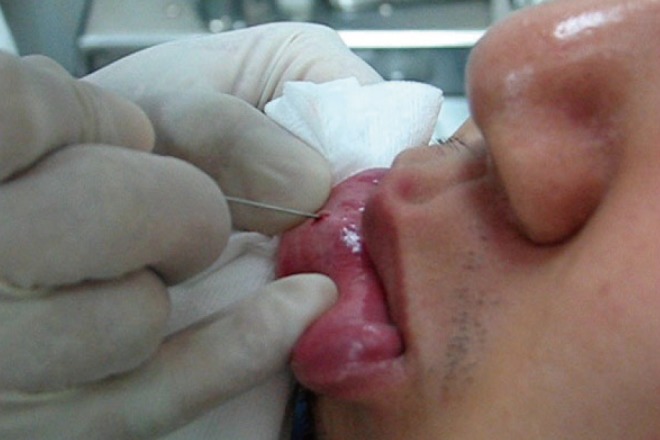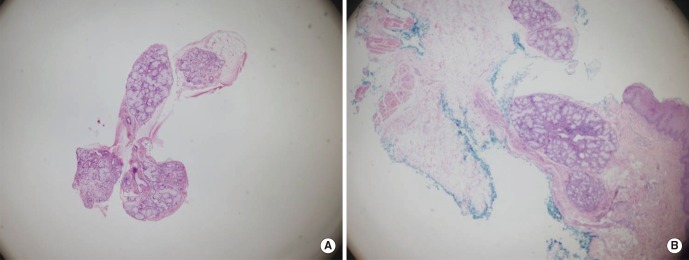Clin Exp Otorhinolaryngol.
2014 Sep;7(3):222-225. 10.3342/ceo.2014.7.3.222.
A Convenient and Less Invasive Technique of Labial Minor Salivary Gland Biopsy Using a Minimal Incision With a Needle Tip
- Affiliations
-
- 1Department of Otorhinolaryngology-Head and Neck Surgery, Seoul National University Hospital and Cancer Research Institute, Seoul National University College of Medicine, Seoul, Korea. jhunhah@snu.ac.kr
- 2Department of Otorhinolaryngology-Head and Neck Surgery, Seoul National University Bundang Hospital, Seoul National University College of Medicine, Seongnam, Korea.
- KMID: 1973474
- DOI: http://doi.org/10.3342/ceo.2014.7.3.222
Abstract
OBJECTIVES
This study was to show the technique and to compare the usefulness and complications of biopsy using a minimal incision with a needle tip of the labial minor salivary glands with those of conventional incisional lip biopsy in the diagnosis of Sjogren's syndrome.
METHODS
We retrospectively reviewed the medical records of the patients who had the labial minor salivary gland biopsy for the diagnosis of Sjogren's syndrome between January 2005 and December 2008. One hundred forty-three patients were enrolled in this study. The yields of diagnostic salivary tissues and complications of the biopsy using a minimal incision with a needle tip and the conventional incisional lip biopsy were compared.
RESULTS
Out of 143 patients, 56 patients underwent the conventional incisional lip biopsy and 87 patients received the biopsy using a minimal incision with a needle tip. In the biopsy using a minimal incision with a needle tip group, adequate salivary gland tissues were obtained in 85 patients out of 87 patients (97.7%). In the conventional incisional lip biopsy group, adequate specimens were acquired in 44 patients out of 56 patients (78.6%). There was no complication after the biopsy using a minimal incision with a needle tip, whereas there was one patient complained transient numbness of the lip after the conventional incisional lip biopsy.
CONCLUSION
The less invasive labial minor salivary gland biopsy using a minimal incision with a needle tip was easy to perform and safe and showed the better result than the conventional incisional lip biopsy in terms of the adequate specimen in the diagnosis of Sjogren's syndrome. So it might be a good alternative to the conventional incisional lip biopsy.
Keyword
MeSH Terms
Figure
Reference
-
1. Jonsson R, Haga HJ, Gordon TP. Current concepts on diagnosis, autoantibodies and therapy in Sjögren's syndrome. Scand J Rheumatol. 2000; 1. 29(6):341–348. PMID: 11132201.2. Vitali C, Bombardieri S, Moutsopoulos HM, Balestrieri G, Bencivelli W, Bernstein RM, et al. Preliminary criteria for the classification of Sjögren's syndrome: results of a prospective concerted action supported by the European Community. Arthritis Rheum. 1993; 3. 36(3):340–347. PMID: 8452579.
Article3. Daniels TE. Labial salivary gland biopsy in Sjögren's syndrome: assessment as a diagnostic criterion in 362 suspected cases. Arthritis Rheum. 1984; 2. 27(2):147–156. PMID: 6696772.4. Pijpe J, Kalk WW, van der, Vissink A, Kluin PM, Roodenburg JL, et al. Parotid gland biopsy compared with labial biopsy in the diagnosis of patients with primary Sjögren's syndrome. Rheumatology (Oxford). 2007; 2. 46(2):335–341. PMID: 16891656.5. Vitali C, Bombardieri S, Jonsson R, Moutsopoulos HM, Alexander EL, Carsons SE, et al. Classification criteria for Sjögren's syndrome: a revised version of the European criteria proposed by the American-European Consensus Group. Ann Rheum Dis. 2002; 6. 61(6):554–558. PMID: 12006334.6. Vitali C, Bombardieri S, Moutsopoulos HM, Coll J, Gerli R, Hatron PY, et al. Assessment of the European classification criteria for Sjögren's syndrome in a series of clinically defined cases: results of a prospective multicentre study. The European Study Group on Diagnostic Criteria for Sjögren's Syndrome. Ann Rheum Dis. 1996; 2. 55(2):116–121. PMID: 8712861.7. Calman HI, Reifman S. Sjögren's syndrome: report of a case. Oral Surg Oral Med Oral Pathol. 1966; 2. 21(2):158–162. PMID: 5215974.8. Cifarelli PS, Bennett MJ, Zaino EC. Sjogren's syndrome: a case report with an additional diagnostic aid. Arch Intern Med. 1966; 3. 117(3):429–431. PMID: 5905071.
Article9. Chisholm DM, Mason DK. Labial salivary gland biopsy in Sjögren's disease. J Clin Pathol. 1968; 9. 21(5):656–660. PMID: 5697370.10. Berquin K, Mahy P, Weynand B, Reychler H. Accessory or sublingual salivary gland biopsy to assess systemic disease: a comparative retrospective study. Eur Arch Otorhinolaryngol. 2006; 3. 263(3):233–236. PMID: 16378222.
Article11. Liquidato BM, Soler Rde C, Bussoloti Filho I. Evaluation of the concordance of sialometry and salivary glands scintigraphy in dry mouth patients. Braz J Otorhinolaryngol. 2006; Jan-Feb. 72(1):116–119. PMID: 16917562.
Article12. Teppo H, Revonta M. A follow-up study of minimally invasive lip biopsy in the diagnosis of Sjögren's syndrome. Clin Rheumatol. 2007; 7. 26(7):1099–1103. PMID: 17522950.
Article13. Delgado WA, Mosqueda A. A highly sensitive method for diagnosis of secondary amyloidosis by labial salivary gland biopsy. J Oral Pathol Med. 1989; 5. 18(5):310–314. PMID: 2769600.
Article14. Greenspan JS, Daniels TE, Talal N, Sylvester RA. The histopathology of Sjögren's syndrome in labial salivary gland biopsies. Oral Surg Oral Med Oral Pathol. 1974; 2. 37(2):217–229. PMID: 4589360.
Article15. Friedman H, Kilmar V, Galletta VP, Cossermelli W. Lip biopsy in connective tissue diseases: a review and study of seventy cases. Oral Surg Oral Med Oral Pathol. 1979; 3. 47(3):256–262. PMID: 84370.16. Smith SR, Shneider BL, Magid M, Martin G, Rothschild M. Minor salivary gland biopsy in neonatal hemochromatosis. Arch Otolaryngol Head Neck Surg. 2004; 6. 130(6):760–763. PMID: 15210559.
Article17. Guevara-Gutiérrez E, Tlacuilo-Parra A, Minjares-Padilla LM. Minor salivary gland punch biopsy for evaluation of Sjögren's syndrome. J Clin Rheumatol. 2001; 12. 7(6):401–402. PMID: 17039183.
Article18. Gorson KC, Ropper AH. Positive salivary gland biopsy, Sjögren syndrome, and neuropathy: clinical implications. Muscle Nerve. 2003; 11. 28(5):553–560. PMID: 14571456.
Article19. Fox PC. Simplified biopsy technique for labial minor salivary glands. Plast Reconstr Surg. 1985; 4. 75(4):592–593. PMID: 3983264.
Article20. Peloro TM, Ramsey ML, Marks VJ. Surgical pearl: "X" marks the spot for the salivary gland biopsy. J Am Acad Dermatol. 2001; 7. 45(1):122–123. PMID: 11423846.
Article
- Full Text Links
- Actions
-
Cited
- CITED
-
- Close
- Share
- Similar articles
-
- A Case of Adenomatous Hyperplasia of the Minor Salivary Glands
- Accuracy of Core Needle Biopsy Versus Fine Needle Aspiration Cytology for Diagnosing Salivary Gland Tumors
- A Case of Mucinous Cystadenocarcinoma in Labial Mucosa of Upper Lip
- Multiple sialolithiasis in sublingual gland: report of a case
- Multiple bilateral malar mucinous cystadenomas in the minor salivary glands



